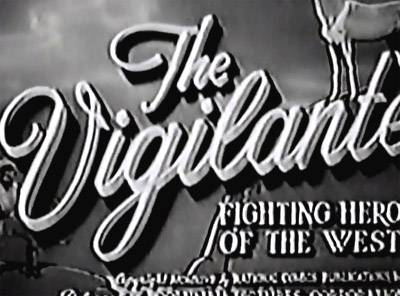
Columbia, 15 Chapters, 1947. Starring Ralph Byrd, Ramsay Ames, George Offerman Jr., Lyle Talbot, Eddie Parker, Robert Barron, Jack Ingram, Hugh Prosser, Terry Frost.
Five “Arabanian” white horses–foreign potentate Prince Amil’s (Robert Barron) gifts to five prominent residents of a rural Hollywood suburb–suddenly become the targets of a gang of crooks led by a mystery man called X-1. Unfortunately for the modern-day horse thieves, the owner of one of the Arabanian steeds is B-western star Greg Saunders (Ralph Byrd), who doubles as the masked crimefighter, The Vigilante. With the assistance of his sidekick Stuff (George Offerman Jr.), Saunders sets out to discover the reason for the crooks’ interest in the equines and is helped by three of the four other horse-owners–rodeo queen Betty Winslow (Ramsay Ames), Police Captain Reilly (Hugh Prosser), and rancher Tex Collier (Ted Mapes). The remaining horse-owner, nightclub proprietor George Pierce (Lyle Talbot), pretends to aid the investigation as well, but is secretly hand-in-glove with X-1’s gang–and just might be its leader.
The Vigilante, based on a minor Action Comics feature, is the best Columbia serial from the studio’s 1945-1947 period–the dark age during which Sam Katzman held the production reins but had yet to retain director Spencer Bennet, whose low-budget expertise polished up several subsequent Katzman outings. Vigilante, like most of Katzman’s Columbia outings, is overlong and under-plotted, but is never as dull or uninteresting as close contemporaries like Who’s Guilty, Son of the Guardsman, or Jack Armstrong.
Arthur Hoerl, George Plympton, and Lewis Clay’s script for The Vigilante is less tediously dialogue-heavy than the Columbia norm, but is extremely repetitious; a full two-thirds of the serial centers on the heavies’ attempted thefts of the Arabanian horses and Saunders’ blocking of said thefts, with the narrative only shifting its focus slightly when the characters begin pursuing one steed’s discarded horseshoes in the last five chapters. Though repetitive, this constant duel over the horses furnishes plenty of action–and also serves to keep the hero at center stage throughout; Saunders is never relegated to the background by rival heavy factions, unlike the nominal protagonists of Jack Armstrong, Gunfighters of the Northwest, and many other Columbia outings.
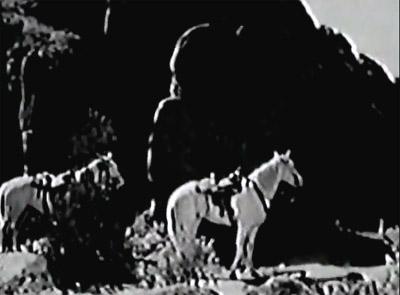
Above: Two of the coveted Arabanian horses.
Hoerl, Plympton, and Clay mishandle the mystery-villain angle of their script, despite introducing an interesting cast of potential suspects; from the first chapter onwards, they show one “suspect” to be so deeply involved in the serial’s villainy that the mystifications surrounding X-1’s identity seem quite pointless (Plympton and company also commit a blatant Mascot-style cheat by having this guilty suspect and X-1 share the screen in one scene). The writers do take care to provide a logical motive for Prince Amil’s occasionally suspicious behavior, however–and come up with a satisfyingly simple explanation of just how the horses became so priceless in the first place. One minor absurdity in the script, incidentally, is not the writers’ fault: the unlikely references to the Vigilante as a secret G-man (in the first and last chapters) were dictated by Columbia’s wish to mollify censors who might have been offended by a hero operating outside the law.
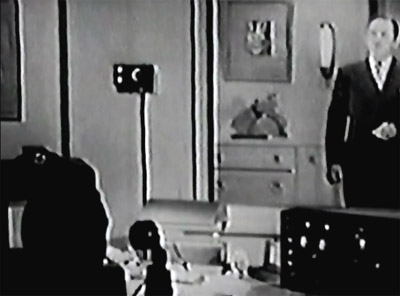
Above: The masked X-1 (seated) gives orders to Jack Ingram via radio and two-way mirror.
Although The Vigilante is definitely padded in spots–especially when X-1 bawls out his henchmen or the heroes sit down to ponder the mystery of the white horses–it’s faster-moving than most Katzman Columbias, with few of Katzman’s beloved “walk from place to place” scenes and numerous action sequences. Said action is executed with greater flair than usual in Columbia’s post-war outings, thanks to the work of stuntmen Eddie Parker, Ted Mapes, and George DeNormand (who, as in Republic’s Dick Tracy outings from the preceding decade, doubles star Ralph Byrd). The frequent fight sequences, though unspectacular, are solid and convincingly energetic; the Chapter Three garage combat, the lengthy stable-yard fight in Chapter Four, and the Chapter Thirteen livery-stable brawl are particularly good. The quality of the fights is particularly surprising considering that Wallace Fox is the director; his two previous Katzman serials, Brenda Starr Reporter and Jack Armstrong, were remarkable (respectively) for nonexistent and perfunctory action scenes; either he was more hampered by time and budget on his earlier Katzman efforts than on Vigilante, or else it took him a little time to figure out how to stage serial action (his previous work had been in features).
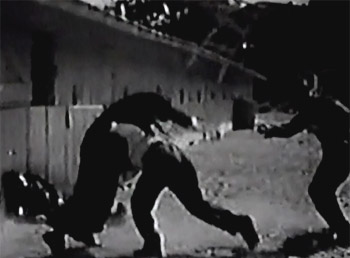

Above: The Vigilante battles heavies in the stable yard (left) and on the stable roof (right) during the Chapter Four fight sequence.
The serial also features many well-done car, horse, and motorcycle chase scenes; the nighttime pursuits in Chapters Six and Seven and the heroine’s horseback escape from the villains in Chapter Thirteen are among the standouts. French Ranch and Corriganville (two locations rarely utilized by serial-makers) provide the roads and hills for these and other scenes, as well as furnishing numerous cabins and ranch buildings; the stable-yards and rodeo arena at Corriganville are also used to good effect, as is an apparently functioning carnival (the generous number of patrons strolling through the carnival grounds helps to dispel the impression of an uninhabited world created by the low budgets of so many post-war serials, both at Columbia and Republic).
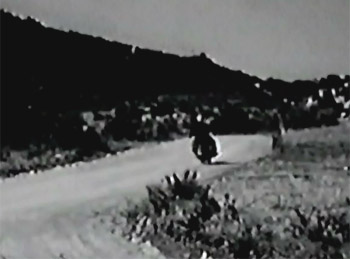
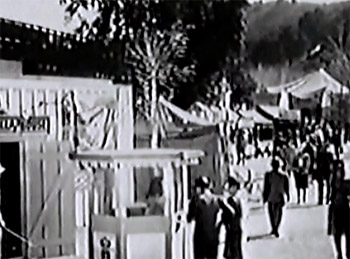
Above left: The Vigilante and Stuff pursue crooks on their motorcycle along a rural road. Above right: The carnival grounds.
Most of the serial’s chapter endings suffer from Columbia’s typical lack of foreshadowing (especially the Chapter Eight cabin explosion, the plunge down a spillway at the end of Chapter Nine, and the explosion at the end of Chapter Fourteen), but several of them are memorable despite weak buildups, most notably the runaway horse-trailer sequence that closes Chapter Two, the Chapter Seven car crash, and the heroine’s encounter with an escaped gorilla (played by Emil Van Horn) at the end of Chapter Five.
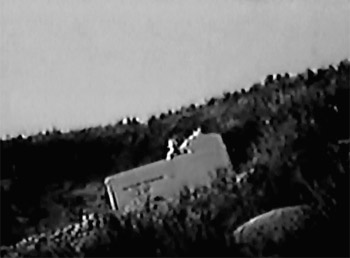
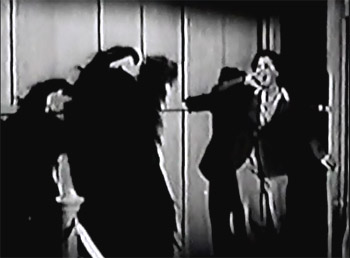
Above left: A trailer containing the hero, his sidekick, and an Arabanian horse takes off downhill. Above right: An escaped carnival gorilla corners the heroine.
The Vigilante benefits immeasurably from Ralph Byrd’s sincere, energetic, and good-humored performance in the title role. Few serial stars were as good as Byrd was when it came to delivering bland dialogue with convincing earnestness, and he uses this talent to enliven the heroes’ many discussions of the horse-stealing mystery. In his scenes as the masked Vigilante, he confronts heavies with much of his old Dick Tracy vigor, but is a bit more relaxed–even suave–when unmasked as “drugstore cowboy” Greg Sanders, delivering amusingly self-deprecating lines with flair (like his quip about writing his own fan mail), and cagily keeping up a pose as a jovial but rather flippant movie star. Byrd even gets to warble a cheery cowboy song in the first chapter, using his Broadway-tenor singing voice for the only time in his serial career.
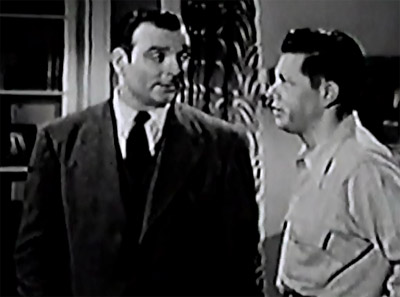
Above: Ralph Byrd with George Offerman Jr.
The cast that supports Byrd is an exceptionally strong one. The sultrily beautiful and New-York-accented Ramsay Ames is somewhat oddly cast as a rodeo performer, but is athletic enough to pull the part off; she also handles her lines with warmth and humor, particularly in her cheerful interchanges with Byrd. George Offerman Jr. underplays effectively as Byrd’s sidekick; his gruffly deadpan manner makes his occasional wisecracks (such as the “cherchez la femme” bit) much funnier than a more boisterous approach would have.
Lyle Talbot is very good as the urbane, double-dealing Pierce, convincingly affable around the good guys and smugly superior when giving orders to his criminal associates. Robert Barron delivers an enjoyably sly and enigmatic performance as Prince Amil, while Jack Ingram–usually a grumbling roughneck–is uncharacteristically slick and self-possessed as Pierce’s nightclub manager, who relays orders to the henchmen but participates in little active villainy.

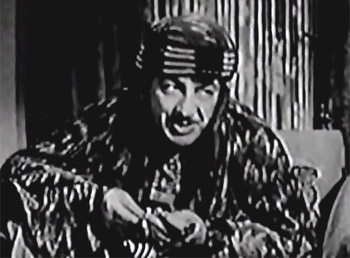
Above left: Lyle Talbot. Above right: Robert Barron.
Stuntman Eddie Parker functions as the serial’s principal action heavy and is quite good in the part, conveying both crafty confidence and imposing physical menace. Tough-sounding Terry Frost serves as his chief partner-in-crime, while George Chesebro and Pierce Lyden play other prominent henchmen; Frank Ellis, Edmund Cobb, Bill Brauer, and Bud Osborne take smaller heavy roles. Lane Bradford and Al Ferguson pop up as members of the hot-car ring smashed by the Vigilante at the beginning of the serial.
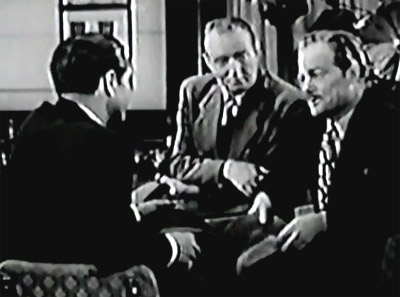
Above, left to right: Henchmen Terry Frost, Eddie Parker, and Pierce Lyden.
Hugh Prosser is good as the concerned and intelligent police captain, while Ted Mapes is likable in his periodical appearances as easygoing rancher Tex Collier. The lovably disreputable Emmett Lynn is very funny as a scraggly and garrulous carnival barker, Ted Adams gets to be colorfully shifty in a small but pivotal role as Prince Amil’s treacherous vizier, and Frank Merlo is stoically sinister as one of Amil’s faithful servants. Rusty Wescoatt gets to play a good guy for once (a tough blacksmith), while Kermit Maynard appears as a policeman. An unidentified actor does an energetic character turn as Sid, the irritable director of the movie-within-a-movie that Greg Saunders is shooting throughout the serial. In a previous version of this review I identified this actor as director Wallace Fox himself, following the Internet Movie Database’s crediting; however, I have since determined that the IMDB is wrong and that the “director” of Saunders’ movie is not Fox, leaving the actual actor’s identity a riddle to me.
The Vigilante’s action scenes, fresh locations, fortunate lack of villainous factionalism, and terrific cast help it to overcome the production weaknesses endemic to all Katzman serials (the padded script, the indifferently edited cliffhangers). While no classic, it’s a pleasant and very watchable chapterplay.
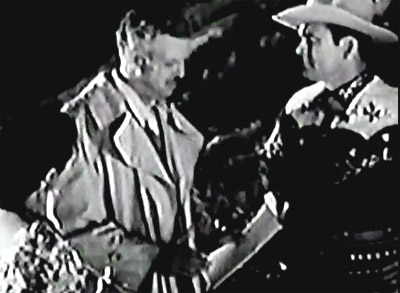
Above: Ralph Byrd’s Greg Saunders receives some directorial instructions.
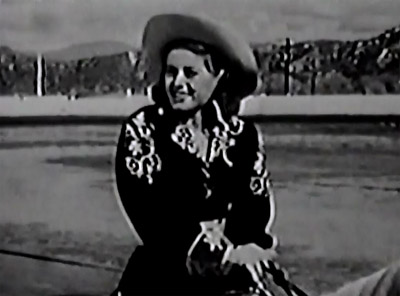
Very few folks these days seem aware that Ralph Byrd did in fact possess a fine singing voice. I can personally attest to that,having heard him sing South of the Border when he made a brief personal appearence at my hometown theater bachk in the early ’40’s . I saw the first chapter of The Vigilante at that same theater. i remember being a bit disapointed having known him only as Dick Tracy. I haven’t viewed the rest of the serial since.None the less, thanks Dan for another good review!
The Vigilante is another Columbia favorite of mine. It’s another well written serial with an interesting story involving the pearls hidden in the shoes of the horses. Ralph Byrd and George Offerman Jr. are a good team in this serial, both actors perform their roles well. A highlight in chapter 1 is when Ralph Byrd sings “Saturday Night In San Antone”, good tune. Ramsay Ames is along for the ride as eye candy, she’s quite lovely looking indeed.
The Vigilante does have one flaw, and it’s a pretty big one, the flaw is that it’s easy to tell right away in the 1st chapter who the villain is. So after watching the whole serial and when the 15th and final chapter comes along, it comes as no surprise when the villain is revealed. But despite the flaw, The Vigilante is still a fun and entertaining serial.
Roar Of The Iron Horse is another Columbia serial with the same flaw. It’s easy to spot right away in the 1st chapter who the villains are.
Suprisingly entertaining storyline, despite the repetitiveness and a way too obvious villain. There just seems to be a lot more energy than was typical for some of these Katzman productions. Enhanced by a good cast throughout, especially Ralph Byrd and Ramsay Ames, who have really nice chemistry together. Robert Barron, Jack Ingram, Hugh Prosser and Lyle Talbot also deliver solid performances. There’s plenty of action and a variety of outdoor locations that liven up what might have been expected to be the usual Columbia snooze-fest of this era. The mystery surrounding why the horses are so sought after offers a nice twist as well.
The title cards must have been done early on, which might explain why the Prince Amil character is credited as Prince Hassan in every chapter.
Thanks also for the well-written and detailed biography of Ramsay Ames, an very underappreciated actress. Attractive and talented, she was another example of a performer that never quite found the right parts to catapult her to greater stardom. (The “leave a reply” option doesn’t seem to be available on her page, so I’m posting my comments and some links related to her here instead).
There’s a great collection of glamour photos and publicity shots at the following website:
There’s also a lengthy biography at the site below, covering much of the same ground as your article. It has some factual errors and is a tad gossipy and given over to excessive coverage regarding her romantic entanglements, but is still very readable:
https://obscureactresses.wordpress.com/2016/03/11/ramsay-ames/
There’s a great anecdote attributed to William Witney where he supposedly said that Republic Studios stuntmen suffered more injuries running on rooftops to get a better look at Ramsay Ames walking across the backlot than were hurt performing dangerous action sequences in the studio’s westerns.